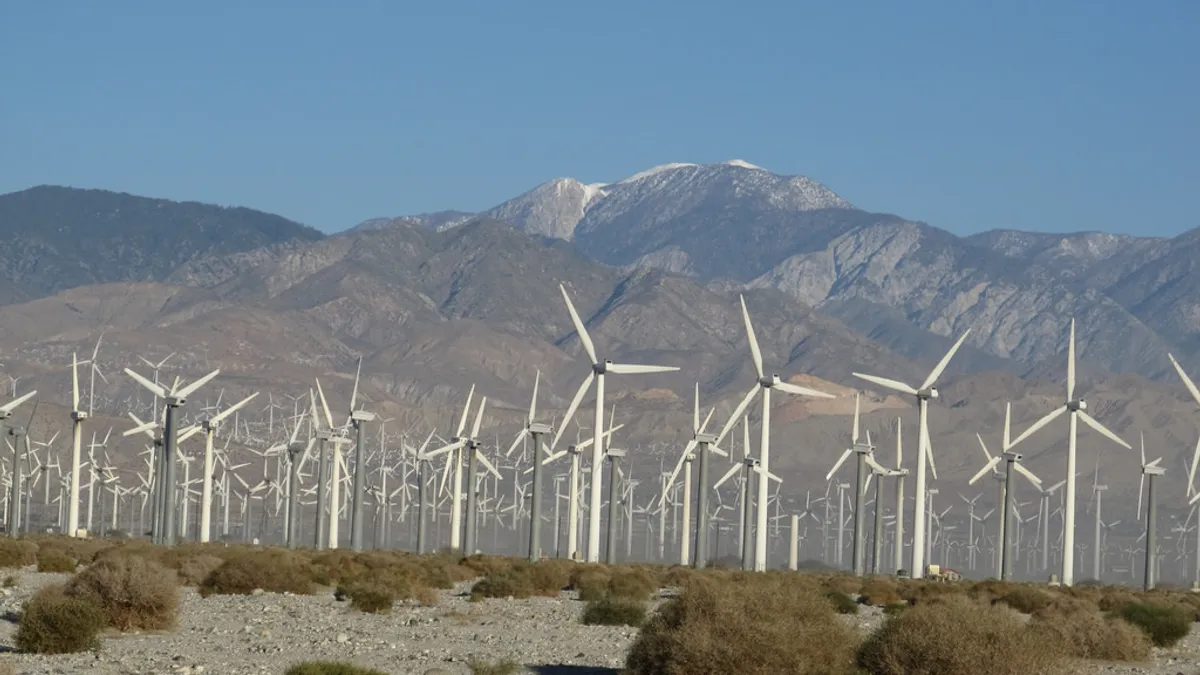Dive Brief:
- Utility-scale wind plants have the potential to provide grid services that match those of a gas plant or hydroelectric facility, the California Independent System Operator (CAISO) has found.
- CAISO, along with Avangrid Renewables, the National Renewable Energy Laboratory, and General Electric, conducted tests at a wind farm near San Diego last year. The takeaway was that "a wind plant could perform as well — and in some cases even better — than a conventional unit," Clyde Loutan, renewable energy advisor and team lead, told Utility Dive.
- The study, published Wednesday, could have global implications for grids that are transitioning to renewables, according to the system operator. It’s just a first step, but "we’re very excited about it," said Anne Gonzales, CAISO senior public information officer.
Dive Insight:
The U.S. has around 105.6 GW of wind generating capacity and it is expected to overtake hydroelectricity as the chief source of renewables in 2020, according to CAISO. The grid operator has 7,774 MW of transmission-connected wind resources, and expects to integrate approximately 3,000 MW of additional wind to meet California’s 60% renewables standard portfolio goal by 2030.
In 2018, CAISO conducted tests to demonstrate that solar power plants equipped with smart inverter controllers can provide reliability services. That was also the gist of this study, Loutan said. Typical utility-scale wind facilities tend to include electronic inverters and with "sophisticated, automatic, grid-friendly controls" these could help provide reliability, according to the report.
CAISO last year performed the tests at a 131.1 MW wind power plant in McCain Valley, east of San Diego, which is operated by Avangrid. The facility includes 57 wind turbines and a "controller," which controls each turbine to ensure that the facility works as a single generator despite each experiencing a different wind speed, Loutan explained.
The tests found that when equipped with an inverter-based smart controller, utility-scale wind facilities can in fact provide grid services, including balancing or regulation up and down, voltage regulation control, frequency response, and active power control through ramping capability, the report said — services that conventional sources like gas plants currently provide. The test fits into a broader strategy of integrating more renewables into the grid by having renewables be part of the solution, Loutan said, adding, "If we need to integrate more, we need the newer ones coming in to have this capability."
CAISO has more than 7,000 MW of wind capacity in its portfolio, and with "relatively simple operational upgrades and market redesigns," virtually all of it could provide, and be compensated for, ancillary services — which in turn could create entirely new markets for renewables.
The study is "a first step toward realizing some of these visionary advances that could be happening," according to Gonzales.
"California is seen as a leader anyway in renewables integration, so this will just not only help us manage the grid, but help us manage a renewable grid moving forward," she told Utility Dive.
However, this doesn’t mean that California will have an easy time transitioning away from gas, Loutan said. The state’s gas fleet is still required during multiple days of cloud cover, when there also isn’t a lot of wind, and CAISO needs address issues including how much storage it would take to tide over such periods.
"I think this test tells you we can get help from the renewables — but it would take some more work to get rid of the conventional stuff," he added.
The next step for the researchers is to take the findings to CAISO’s Board of Governors, and tell them "wind plants can do everything that a conventional unit, a hydro or gas unit can do," according to Loutan.















